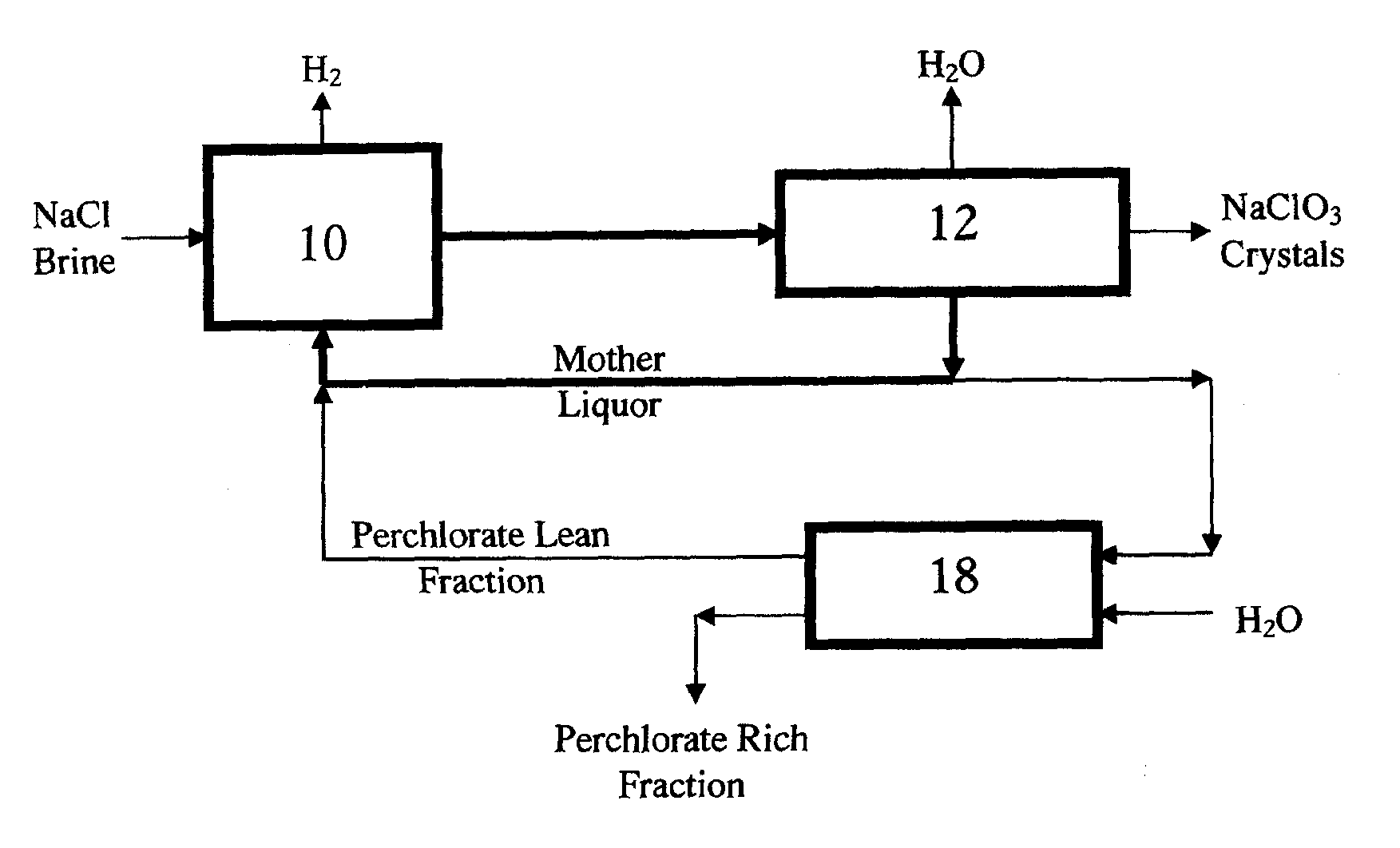Perchlorate removal from concentrated salt solutions using amphoteric ion-exchange resins
a technology of amphoteric ion exchange resin and concentrated salt solution, which is applied in the direction of ion exchangers, water/sludge/sewage treatment, water contaminants, etc., can solve the problems of reducing the overall cell efficiency, heavy metal contamination, and no work on the removal of high perchlorate content from complex ionic solution matrices, etc., to improve reaction efficiency, prolong process operation time, and improve the utilization of raw materials
- Summary
- Abstract
- Description
- Claims
- Application Information
AI Technical Summary
Benefits of technology
Problems solved by technology
Method used
Image
Examples
example 1
[0093]A chlorate liquor (pH 8.2) containing various inorganic salts at the concentrations shown in Table 2 was prepared. A 1200 ml portion of the chlorate liquor was pumped at a volumetric flow rate of 20 ml / min in a downward direction through a jacketed column filled with 400 cm3 of amphoteric (ion retardation) resins (trade name: Dowex 11A8) at room temperature. This was followed by a 90° C. deionised water wash at a volumetric flow rate of 20 ml / min in a co-current direction. The eluent exiting the bottom of the ion retardation column was collected in fractions and analyzed for its salt components using Dionex 120 Ion Chromatography unit and the results are shown in FIG. 4.
TABLE #2Perchlorate removal from Chlorate Liquorusing Amphoteric resins (Dowex 11A8)Cr2O7−2Cl−ClO3−ClO4−g / Lg / Lg / Lg / LChlorate Liquor Feed4.458.0365.719.3
[0094]The results indicate that using an amphoteric (ion retardation) resin column, selective removal of perchlorate ions from chlorate liquor by properly selec...
example 2
[0095]Chlorate liquors (pH 6.4-8.2) containing various inorganic salts at the concentrations shown in Table 3 were prepared. Between 1200-5000 ml portions of chlorate liquor were pumped at a volumetric flow rates between 20-50 ml / min in a downward direction through a jacketed column filled with 400 cm3 of amphoteric (ion retardation) resins (trade name: Dowex® 11A8) at room temperature. This was followed by 80 to 90° C. deionised water wash at a volumetric flow rate of 20 ml / min in a co-current direction. The eluent exiting the bottom of the ion retardation column was collected in fractions and analyzed for its salt components using ion chromatography. The apparent resin capacity, as indicated by the amount of perchlorate retarded on the column, is illustrated as a function of perchlorate concentration of the feed process stream is shown in FIG. 5.
TABLE #3Perchlorate removal from Chlorate Liquorusing Amphoteric resin (Dowex 11A8)Cr2O7−2Cl−ClO3−ClO4−g / Lg / Lg / Lg / LChlorate Liquor Feed -...
example 3
[0096]A 1200 mL sample of a chlorate liquor (pH 8.2) containing 4.6 gpl dichromate, 63.4 gpl chloride, 418.8 gpl chlorate and 21 gpl perchlorate was pumped at a volumetric flow rate of 20 ml / min in a downward direction through a jacketed column filled with 400 cm3 of amphoteric ion exchange resins (trade name: Diaion® AMP01) at room temperature. This was followed by 85° C. deionised water wash at a volumetric flow rate of 20 ml / min in a co-current direction. The eluent exiting the bottom of the ion retardation column was collected in fractions and analyzed for its salt components using ion chromatography (see detail results in Table 4 and FIG. 6).
TABLE #4 Perchlorate removal from Chlorate Liquor using Amphotericresin (Diaion AMP01 Amphoteric Resin)VolumeTempCr2O7−2Cl−ClO3−ClO4−mL° C.g / Lg / Lg / Lg / LChlorate Liquor Feed214.663.4418.821.0 200211.00.90.20.0 400214.656.6265.30.0 600214.563.2426.00.0 800214.765.0442.50.01000214.563.5432.50.71200304.663.1421.414.8Water Wash1450852.645.6369.22...
PUM
 Login to View More
Login to View More Abstract
Description
Claims
Application Information
 Login to View More
Login to View More - R&D
- Intellectual Property
- Life Sciences
- Materials
- Tech Scout
- Unparalleled Data Quality
- Higher Quality Content
- 60% Fewer Hallucinations
Browse by: Latest US Patents, China's latest patents, Technical Efficacy Thesaurus, Application Domain, Technology Topic, Popular Technical Reports.
© 2025 PatSnap. All rights reserved.Legal|Privacy policy|Modern Slavery Act Transparency Statement|Sitemap|About US| Contact US: help@patsnap.com



